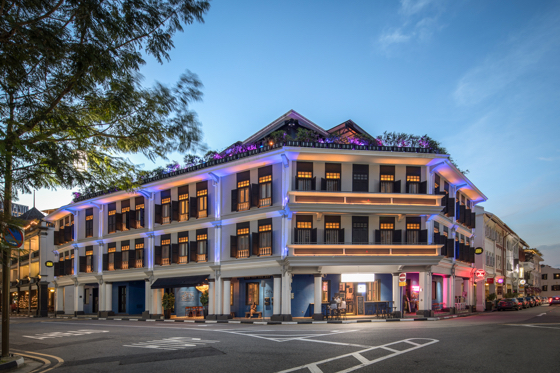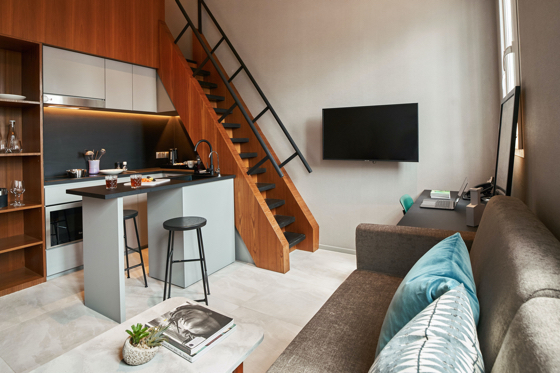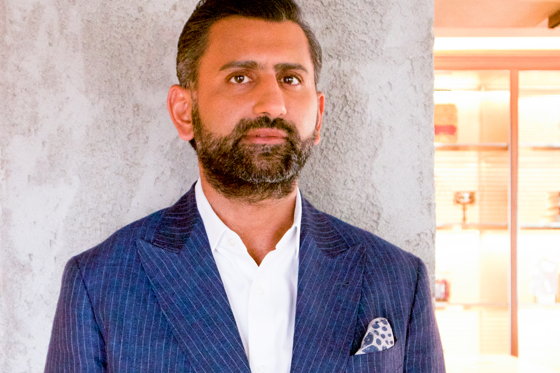Before today’s lean operating model was almost forced upon the hotel world, Singapore’s 8M Real Estate (8MRE) was working on its own plan to make its boutique hotels with switched-on F&B housed in local shophouses more lean, mean and profitable.
Along the way, the team led by founder and CEO Ashish Manchharam learned that a hybrid concept with extended-stay traits like kitchenettes, and by partnering with great local F&B concept creators to draw locals from the burgeoning neighborhoods it chose for development, were among the answers.
The hotel group, 8M Collective, has been able to drive profitability by limiting labor with a more all-inclusive amenities program that meets the needs of its highly mobile and digitally savvy guests. The result before temporarily shutting down the rooms business due to COVID-19: a better-than-expected 20% to 30% gross operating profit for a three-hotel, 110-room local portfolio with legs to grow.
8MRE owns 55 shophouses today, but Manchharam said with more than 4,000 of these buildings in Singapore, it could easily double its portfolio in the mid-term, especially because so many of them are in CBDs, one of the group’s main criteria for growth. More exponential growth could come into play, especially if the company gives management to a global brand.
Before COVID shut down the rooms business until what is expected to be closer to the end of this year, the 8M Collective (Ann Siang House, KeSa House and Wanderlust, which opened on February 1 and had to close by the end of that month) accounted for about 30% of the 8MRE portfolio’s revenue, according to Manchharam.
The restaurants have remained open in the shophouses, and during Singapore’s “circuit breaker” moment the group is reviewing its systems as well as potential upgrades to enhance the overall experience.
“We’re considering how these properties sit within the context of the next couple of years,” Manchharam said. “Do we have to do more than just upgrading? By self-operating we have a bit more flexibility in terms of when you close and open. It’s providing us an opportunity to take a look at our portfolio in a meaningful way.”

When the hotels come back online, revenue likely will not return to the previous levels for 12 to 18 months, Manchharam said, as the brand does not have the resort amenities for stay-cationers. “It’s really when travel comes back,” he said. “Our worrying stat is visitor arrivals, as there were 880 last month.”
As a result, Manchharam said the small group is tossing around ideas like giving management to a third party – just from a distribution perspective. “I’m sure that a lot of operators in our space are doing the same thing,” he added.
In the meantime, another 50-room Singapore hotel on New Bridge Road near the Parliament building is under construction (with architect WOHA, which did the iconic ParkRoyal Pickering). Otherwise, Manchharam said COVID-19 has put the brakes on new development for now. Longer term, along with 8MRE’s unnamed foreign institutional investor, there remains an appetite to re-start more significant growth of the group’s hotel business.
The 6-year-old, Singapore-based property investment company already has made a name for itself by assembling the shophouses, now known for curated F&B and a mix of guest rooms and other boutique commercial tenants.

“It took us 12 months to get to the optimal positioning [as an all-inclusive, longer-stay optional model for the hotel component], and we needed a different type of inventory to get there,” said the 41-year-old Manchharam, who spent his formative years working across Asia Pacific on the capital side for JLL. “So, it was really an eye-opener around how we got there. At the end of the day, it worked and ended up probably better than expected.”
8MRE wanted the hotel product to be flexible enough to accommodate 20% to 30% extended-stay guests. “That way, we’re not starting from zero every month,” Manchharam said. “That was part of our revenue process and it fit a lot of the aspirations that we had.”
Efficiency is the other mantra of the 8M Collective, with labor costs running at an enviable 20%. “For properties with 100 rooms or less, it is a lot more difficult in these big cities to be able to operate in an efficient way,” Manchharam said. “And so, that’s how we came out with our model – through the understanding and the knowledge that we just want to do a room’s business here. Let’s focus on that and work with outside experts for F&B.”
Looking ahead, the owner-operator also believes it will continue to be crucial to offer the authentic local experience, which has to make F&B a major selling point. “It’s a huge part of the hotel space that we’re in. It is important because people want to go to cool restaurants and cool bars when they go to the city,” Manchharam said.
And because of great amenities, that actual hotel product need not be full-service, Manchharam added. “It can be really great rooms and great amenities, but we can also be operationally lean with it. Taking all of that together, it can be replicated in different cities. Now, it will work in some and won’t work in others… It’s a hybrid hotel product, but in some ways serving all the needs.”

To come back meaningfully after COVID, the group plans to promote the fact that it has smaller properties with fewer people to worry about social distancing. “Maybe there is a market for those a bit more cautious about COVID being a risk and not wanting to stay in 400-room hotels,” Manchharam said. “We think it could be a trend. We only try to capture a small part of that trend because we’re not that big. But we are starting to see this in other parts of our business.” He points to people moving out of larger offices into their smaller shophouse properties because they are only two floors with two tenants versus 20 floors with 20 tenants.
Concept with legs?
Flexibility is what drives 8M Collective and its “House” concept enables price flexibility with less housekeeping and longer stays. “The idea was providing everything [laundry, kitchenette] within a single price,” Manchharam said. “It allows you to stay longer because you have your room and then the common areas were more meant to be for people to hang out, work, meet people, live in those areas.”
Manchharam also points to more companies trying to do the right thing for their people. “If we take that as a potential trend, it might be something that we can leverage when the travel comes back.”
The numbers don’t lie either, as ADR and occupancies were ramping nicely in 2018-19 with the premium property, Ann Siang House, getting up to a S$300 (US$219) rate. KeSa House quickly ramped up in two months when the expectation was six months.
“We’ve believed that the concept works,” Manchharam said. “It’s just a matter of when things get back to normal, which can be a year – it can be three years. And we have to see where things are and what the new norm looks like… And whether the flex living still work for the future is something that we would need to see in our properties before we can really push hard on it… What if people say, ‘We want to stay at the big international brands because they have the standards that we feel comfortable with.’ So, we don’t know where that will end up and we probably need to see what it looks like before we can really push and say, ‘This is our inspiration.’”
Bigger effort than expected
After 13 years with JLL, Manchharam’s group unexpectedly became an operator because the group couldn’t find the right hotelier to run the business. It helped that his family had a hotel business background with properties in Bali.

He also grew up among the shophouses and came to understand how they evolved into enclaves for fashion and F&B. While at JLL, he better realized how these densely populated areas could be further transformed and repositioned with the right tenants, especially on the F&B side.
“We’ve been figuring out how to make it work within the Singapore context, as well,” he added, “because every market is different in terms of what people want, what works and what doesn’t work. So, it was a matter of spending a lot of time researching, understanding what’s out there and then trying to recreate what we think would work in the local context… It was a lot of trial and error and there was obviously a lot of time dedicated towards it.”
The company has grown from an original six people to about 70 today, including 35 people in the corporate office (five on the hotel team) and about 30 people on the frontlines at the hotels. His leading collaborator on the rooms side is COO Sarah Villarreal, who has helped business for more than two years.
“When you’re growing a company, which is unknown, it’s hard to attract people,” Manchharam said. “Therefore, there was a lot of learning about how you actually bring in the right people. Through that process I learned how important it is to communicate… I am transparent with communication, particularly with the company and the teams and what we aspire to do.”
Manchharam said he tried to keep everyone motivated by ensuring that their voices heard. “One of the things that we always try to do to set ourselves apart is being as innovative as possible. We’re trying to be the market leader in that innovation, and therefore we need to have as much feedback and information from our team as possible.”
When it comes to his inspiration, Manchharam cites the Ace brand because of its similar approach to F&B with local operators. He also mentioned W hotels when it first started because of its ability to drive a lot of value from its public spaces.
Today he likes to talk about the Trunk Hotel in Tokyo. “They’ve done a great job with F&B, ensuring there’s always this buzz in the common space,” Manchharam said.
All of these inspiring concepts are successful because of their social spaces. Consider the current “social distancing” trend, is Manchharam worried about customer needs evolving away from the communal component?
“In my opinion, in the bigger picture it’s a short-term blip,” he says. “We seem to have events every 10 years and some take longer to recover, while others are quicker. But my view is that human nature is social. Eventually, when people get comfortable, there’s a vaccine or whatever it may be, things will go back to 2019 levels… it’s just a matter of time, in my opinion. I remain bullish on the space.”
